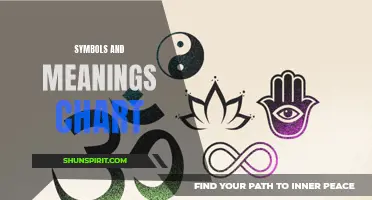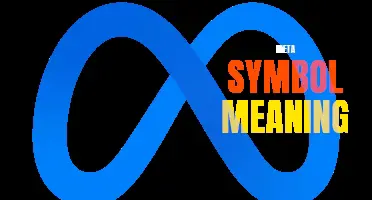
Saint Patrick's Day is a vibrant and spirited celebration observed around the globe on March 17th. This festive holiday is filled with lots of green attire, parades, and, of course, the iconic symbols associated with Saint Patrick himself. From shamrocks to leprechauns, these symbols hold deep meanings that are rooted in Irish folklore and the rich history of the patron saint of Ireland. So let's dive into the world of St. Patrick's Day symbols and unravel the stories and significance behind them.
What You'll Learn
- What are the symbols associated with St. Patrick's Day and what do they represent?
- What is the meaning behind the shamrock as a symbol of St. Patrick's Day?
- Are there any other symbols besides the shamrock that are commonly associated with St. Patrick's Day?
- How did the tradition of wearing green on St. Patrick's Day originate and what does it symbolize?
- Are there any specific symbols or representations of St. Patrick himself?

What are the symbols associated with St. Patrick's Day and what do they represent?
St. Patrick's Day is a cultural and religious holiday celebrated on March 17th every year. It is a day to honor Saint Patrick, the patron saint of Ireland, who is credited with bringing Christianity to the country. This holiday has become popular worldwide, with people from all walks of life joining in the festivities. One of the most notable aspects of St. Patrick's Day is the use of various symbols that are associated with the holiday. These symbols add to the joy and excitement of the celebrations and hold a significant meaning.
The Shamrock:
Perhaps the most iconic symbol of St. Patrick's Day is the shamrock. This three-leafed plant is believed to have been used by Saint Patrick to explain the concept of the Holy Trinity to the people of Ireland. Each leaf represents a different part of the Trinity: the Father, the Son, and the Holy Spirit. Wearing or displaying a shamrock on St. Patrick's Day has become a way to honor Saint Patrick and celebrate Irish heritage.
Leprechauns:
Leprechauns are mythical creatures in Irish folklore that are often associated with St. Patrick's Day. These mischievous little beings are depicted as wearing green clothing and hiding pots of gold at the end of rainbows. While they may not have a direct connection to Saint Patrick or the religious aspect of the holiday, they have become an integral part of the festive spirit surrounding St. Patrick's Day.
The Color Green:
Green is the dominant color associated with St. Patrick's Day. It has been linked to Ireland for centuries and is often referred to as "the Emerald Isle" due to the country's lush green landscapes. Wearing green on St. Patrick's Day is seen as a way to celebrate Irish culture and show solidarity with the Irish people. Many cities around the world also dye their rivers or fountains green on this day to mark the occasion.
Irish Music and Dance:
Traditional Irish music and dance play a significant role in St. Patrick's Day celebrations. Festivities often include lively performances of Irish folk music, as well as traditional Irish Step Dancing. These cultural expressions are deeply rooted in Irish history and are a testament to the rich heritage of the country. They add an element of joy and vibrancy to the celebrations and are enjoyed by people of all ages.
The Celtic Cross:
The Celtic Cross is another symbol associated with St. Patrick's Day. This distinctive cross features a ring surrounding the intersection of the arms, providing a unique design that sets it apart from other crosses. The Celtic Cross has its origins in ancient Celtic paganism but was later incorporated into Christianity. It represents the fusion of the pre-Christian and Christian traditions in Ireland, making it a powerful symbol of Irish identity and faith.
Overall, the symbols associated with St. Patrick's Day hold deep cultural, religious, and historical significance. They provide a way for people to connect with their Irish heritage and celebrate the impact of Saint Patrick on Irish society. Whether it's wearing a shamrock or listening to traditional Irish music, these symbols contribute to the festive atmosphere that surrounds St. Patrick's Day and remind us of the rich traditions that have shaped the holiday.
The Intriguing Meanings Behind Chinese Symbols
You may want to see also

What is the meaning behind the shamrock as a symbol of St. Patrick's Day?
The shamrock is a well-known symbol associated with St. Patrick's Day and Irish culture. This three-leafed clover has been used as a symbol of Ireland for centuries and is often seen as a sign of good luck. But what is the meaning behind this beloved symbol?
The shamrock's connection to St. Patrick's Day can be traced back to the patron saint of Ireland himself, St. Patrick. According to legend, St. Patrick used the shamrock to explain the concept of the Holy Trinity to the Irish people during his Christian mission in the 5th century.
The Holy Trinity is a fundamental belief in Christian theology, which states that God exists as three persons: the Father, the Son (Jesus Christ), and the Holy Spirit. St. Patrick used the three leaves of the shamrock to illustrate this concept, with each leaf representing one person of the Holy Trinity.
The use of the shamrock as a symbol of St. Patrick's Day stems from this story and has become an important part of Irish cultural and religious identity. The shamrock is often worn as a decorative element on St. Patrick's Day and is incorporated into various festivities and parades celebrating Irish heritage.
In addition to its religious significance, the shamrock also carries other meanings and symbolism. It is widely associated with luck and good fortune, with each leaf of the clover representing a different aspect of luck: faith, hope, and love. Many people believe that finding a four-leafed clover, a rare variation of the shamrock, brings even greater luck.
The shamrock is also a symbol of Ireland itself, representing the country's rich heritage and cultural identity. It is frequently used in Irish-themed decorations, clothing, and other products, especially during St. Patrick's Day celebrations.
Overall, the shamrock holds a deep and significant meaning as a symbol of St. Patrick's Day. It represents the Holy Trinity and is a reminder of Ireland's cultural and religious roots. It also embodies luck and good fortune, making it a beloved symbol embraced by people all around the world during this festive holiday.
Unveiling the Enigma: Decoding the Symbol on Gaara's Head
You may want to see also

Are there any other symbols besides the shamrock that are commonly associated with St. Patrick's Day?
St. Patrick's Day is a widely celebrated holiday that honors the patron saint of Ireland, Saint Patrick. It is traditionally observed on March 17th, the date of Saint Patrick's death in the early 5th century. The holiday has become known for its festivities, parades, and widespread display of the color green. While the shamrock is undoubtedly the most famous symbol associated with St. Patrick's Day, there are several other symbols that are commonly associated with the holiday.
The Celtic Cross is one such symbol. This cross combines a traditional Christian cross with a circle, which is said to represent eternity. The Celtic Cross has deep historical and religious significance in Ireland, and it is often seen as a symbol of Irish heritage and pride. On St. Patrick's Day, you may see Celtic Crosses incorporated into decorations, jewelry, and other festive items.
Another symbol associated with St. Patrick's Day is the leprechaun. Leprechauns are small mythical creatures from Irish folklore, known for their mischievous nature and their pot of gold at the end of the rainbow. They are often depicted as wearing green clothing, including a top hat and buckled shoes. Images of leprechauns can be found on everything from greeting cards to clothing to decorations during the St. Patrick's Day season.
The harp is another symbol commonly associated with St. Patrick's Day. The harp has been an emblem of Ireland for centuries, appearing on Irish coins and official documents. It is also the official symbol of Ireland and can be found on the country's coat of arms. The harp is often seen on St. Patrick's Day decorations and is a nod to the rich musical traditions of Ireland.
The Claddagh ring is a traditional Irish symbol associated with love, loyalty, and friendship. It features a heart held by two hands and topped with a crown. The Claddagh ring is often given as a gift to symbolize love and friendship, and it is a popular choice for St. Patrick's Day jewelry.
Lastly, the rainbow is a symbol that is often associated with St. Patrick's Day. Legend has it that leprechauns hide their pots of gold at the end of rainbows, adding to the magical nature of the holiday. Rainbows are often depicted in St. Patrick's Day decorations, and you may see them incorporated into parade floats and other festivities.
While the shamrock may be the most well-known symbol associated with St. Patrick's Day, these other symbols also play a significant role in the holiday's celebration. From leprechauns to Celtic Crosses, each symbol brings its own unique meaning and adds to the festive spirit of St. Patrick's Day. So, don your green attire, embrace the luck of the Irish, and celebrate this beloved holiday with all of its associated symbols.
Exploring the Deep and Mystical Meaning Behind the 'NA' Symbol
You may want to see also

How did the tradition of wearing green on St. Patrick's Day originate and what does it symbolize?
The tradition of wearing green on St. Patrick's Day dates back to ancient times, rooted in Irish folklore and mythology. Green has long been associated with Ireland, known as the "Emerald Isle" due to its lush green landscapes. The color holds deep cultural and historical significance for the Irish, and wearing green on St. Patrick's Day is a way for people of Irish descent around the world to celebrate their heritage.
The origins of the tradition can be traced back to the story of St. Patrick himself. St. Patrick is the patron saint of Ireland, credited with bringing Christianity to the island in the 5th century. According to legend, he used the three-leafed shamrock, which is green in color, to explain the concept of the Holy Trinity to the pagan Irish people. The shamrock became a symbol of Ireland and St. Patrick, and wearing green on his feast day became a way to honor him.
The tradition of wearing green on St. Patrick's Day became more prominent as Irish immigrants spread across the world in the 18th and 19th centuries. In countries such as the United States, Canada, and Australia, where large numbers of Irish immigrants settled, wearing green on St. Patrick's Day became a symbol of Irish pride and identity.
Wearing green on St. Patrick's Day is also associated with luck. It is believed that wearing green can protect against evil spirits and bring good fortune. This belief likely originated from Irish folklore, which is rich with stories of magical creatures and spirits. The tradition of wearing green on St. Patrick's Day may have been a way to ward off these supernatural beings and ensure a year of prosperity and good luck.
Today, wearing green on St. Patrick's Day has become a widespread practice, embraced by people of all backgrounds as a way to join in the festivities. From green clothing and accessories to green face paint and temporary tattoos, people go all out to show their St. Patrick's Day spirit. Parades, parties, and celebrations featuring green decorations are also common during this time.
In conclusion, the tradition of wearing green on St. Patrick's Day originated from the association of the color with Ireland's landscapes and the story of St. Patrick. It symbolizes Irish pride, identity, and luck. Whether you're Irish or not, wearing green on St. Patrick's Day is a fun and festive way to celebrate this beloved holiday. So, dig out your green clothes and accessories and join in the St. Patrick's Day fun!
Understanding the Symbols on Your AC Remote: Decoding Their Meanings
You may want to see also

Are there any specific symbols or representations of St. Patrick himself?
St. Patrick, the patron saint of Ireland, is a well-known figure who is celebrated each year on March 17th. While there are many symbols associated with St. Patrick's Day, such as the shamrock and the color green, there are not many specific symbols or representations that are directly linked to St. Patrick himself.
One possible reason for this is that St. Patrick was not a visual artist or a figure whose physical appearance has been well-documented. Most of what we know about St. Patrick comes from the written accounts and legends associated with him, rather than visual representations.
However, there are a few symbols and representations that are often connected with St. Patrick. One of the most common is the image of St. Patrick holding a shamrock. The shamrock is said to have been used by St. Patrick to explain the concept of the Holy Trinity, and it has since become a symbol of Ireland and St. Patrick's Day. Some depictions of St. Patrick also show him holding a crozier, or bishop's staff, which symbolizes his role as a bishop and leader of the Christian church in Ireland.
Another common symbol associated with St. Patrick is the snake. According to legend, St. Patrick is said to have banished all snakes from Ireland. While this is considered a myth, it has become a popular symbol associated with St. Patrick's Day. Some representations of St. Patrick depict him standing on top of a snake or holding a staff with a snake wrapped around it.
In addition to these symbols, there are also various representations of St. Patrick in art and statues. These depictions often show a bearded man in bishop's robes, holding a shamrock or a staff. However, these representations can vary and may not always be an accurate portrayal of St. Patrick himself.
Overall, while there are not many specific symbols or representations of St. Patrick himself, there are a few commonly associated with him. The image of St. Patrick holding a shamrock and the idea of him banishing snakes from Ireland are two of the most well-known symbols of St. Patrick. However, it is important to remember that these symbols and representations are often based on legends and may not necessarily reflect the true physical appearance of St. Patrick.
Unlocking the Meaning: Understanding Enlightenment Buddhist Symbols and Their Significance
You may want to see also
Frequently asked questions
The shamrock is a symbol commonly associated with St. Patrick's Day celebrations. It is said that St. Patrick used the three-leafed clover to explain the concept of the Holy Trinity to the Irish people during his mission work. Each leaf represents a different aspect of the Trinity: the Father, the Son, and the Holy Spirit.
Green is associated with St. Patrick's Day because it is the color commonly associated with Ireland, also known as the "Emerald Isle." The color green is also traditionally associated with spring, new life, and good luck, making it a fitting choice for a holiday celebrating Irish heritage and culture.
Leprechauns are mythical creatures from Irish folklore and are often depicted as mischievous little men wearing green. They are believed to be shoemakers who hide their pots of gold at the end of the rainbow. Leprechauns are associated with St. Patrick's Day as they are considered to be part of Irish mythology and folklore, adding to the whimsical and magical nature of the celebrations.
The Celtic cross is a symbol commonly associated with Irish Christianity and is often seen on St. Patrick's Day. It is a cross with a circle intertwined, representing the sun or eternity. It combines the Christian cross with pagan Celtic symbolism, reflecting the unique blend of religious and cultural influences in Ireland's history. Essentially, it serves as a visual representation of the deep connection between Christianity and Irish heritage.







